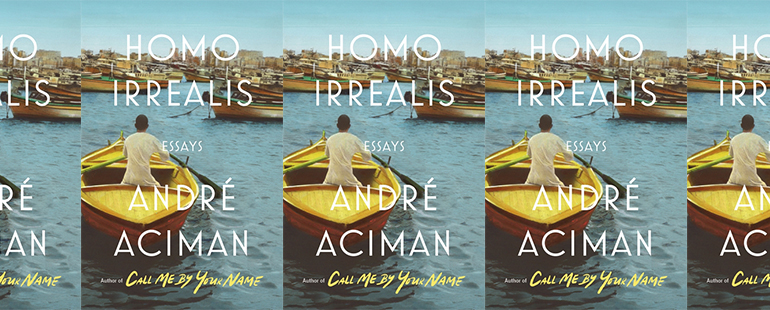Homo Irrealis by André Aciman

Homo Irrealis
André Aciman
Farrar, Straus and Giroux | January 19, 2021
“The irrealis mood can’t really even be written in, much less thought in. But it’s where we live,” writes André Aciman, author of Find Me and Call Me by Your Name, in his new collection of essays, Homo Irrealis. The collection hangs somewhere between the story of a writer coming into being and a description of the feeling of aliveness to which a writer may be especially attuned. We see Aciman as a child in Egypt longing for France. We see him then in France longing for the version of France he longed for in Egypt. We see him as a young adult in New York, heartsick, stumbling into showings of Rohmer’s Six Moral Tales. We see him, years later, traveling to Freud’s Rome and Dostoevsky’s St. Petersburg. In these scenes, the act of writing itself—the writer as writer—disappears in a vanishing trick of the irrealis mood.
The irrealis, as Aciman uses it, doesn’t constitute a single paradox but a whole zone of paradox. Grammatically, it’s the zone where “could’a, would’a, should’a” meet their own unlikelihood, at the moment of their greatest unlikeliness. In each essay, Aciman includes some riff on the following: “a might-have-been that never really happened but isn’t unreal for not happening and might still happen, though we feel it might still but cannot happen.” His syntactical unwieldiness is used to make a point about the temporal contradictions inherent to the irrealis mood. This point, ultimately, is about how we experience the facts of our own existence: “We remember best what could have happened, but never happened.”
In the introductory essay, Aciman describes a photo of himself as a boy on his last day in Egypt before his Jewish family emigrated to France. The boy stares out and seems to ask, “What have you done to me?” Aciman looks back and asks himself, “What in God’s name have I done with my life?” Art, by lending form to life, allows the many versions of the self to answer each other—almost.
Most of the essays focus on a book, film, poem, or piece of music, but they aren’t exactly works of criticism. Rather than taking the position of the critic, Aciman steps into the role of artist in order to interrogate the irrealis. Art, he says, asks us “to see what’s not there to be seen,” and “artists see other than what is given to be seen in the ‘real world.’” In this way, artist, reality, and the work of art itself continually give way to and create each other. Aciman, borrowing from Edward Hopper and Monet’s descriptions of the relationship between themselves and their subjects, calls this triangulation the “endless traffic” between “form and experience,” the “visible and invisible.”
The most successful of Aciman’s essays, a sequence about his viewings of Rohmer’s Six Moral Tales, beautifully demonstrates this principle. Rohmer’s highly designed world appeals to a young Aciman who enters the theater, lonely and hoping for a “state of reverie to blossom” between him and the film. Scenes from Aciman’s own love life drift across descriptions of encounters between men and women in the films. But Aciman resists simple identification between himself and the films’ characters: it’s not enough to point out the Rohmerian encounters in his life. Twenty years from his last viewing of Chloe in the Afternoon, the woman who broke up with Aciman just prior to his first viewing of the film appears again in his life. Their meeting connects moments across time in a design Aciman recognizes from Rohmer. He realizes only then that the films, while not “about” his life, are, rather, a “template” for his life. They have the power to draw scattered moments into significance.
The irrealis mood develops—blooms, to use Aciman’s word—from this kind of glimpsed significance. Aciman cannot inform his younger self of the full meaning of a pattern of meetings between lovers and ex-lovers that wouldn’t be completed for decades and wouldn’t be visible, except through Rohmer’s films. He can only feel a retrospective nostalgia that runs parallel to his younger self’s anticipatory longing. Herein lies one of most compelling arguments the book makes: that as makers and viewers of art—as humans—we seek out the mood and sensation of the irrealis because we find deep pleasure in it despite the pain it also brings.
Aciman succeeds in delivering that pleasure again and again, though at times, it is easy to feel further removed from its source. To take a paradox fundamental to art as the main subject for a collection of essays on art risks embarrassment akin to wearing your underwear over your clothes. More gravely, it risks pointlessness, redundancy, and humorlessness. One essay on Beethoven that begins with Julia Child folding egg whites into a soufflé batter puts Aciman’s tautological risk (his underwear) on full display: He proposes an idea of what a great work of art should do, gives example of great artists who work functions this way, then confirms his proposal.
A broader investigation of the irrealis might have answered some lingering questions, like why we seek out disturbing sensations, anticipating our own nostalgia and displacing ourselves into the past and future, or why we want to live in the irrealis mood. Though Aciman doesn’t directly address these concerns, he makes room for them by persistently placing himself in view of himself. At a café in St. Petersburg, Aciman expresses a wish to return the next day, “because I’ll find something that I know might still take days to pinpoint and understand.” By daring to call forth the irrealis mood, to summon what we usually skitter around and stumble upon, Aciman sets the mood—incurring the awkwardness of doing so, and giving us the chance to realize something that might take a long time to understand.



